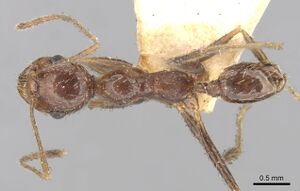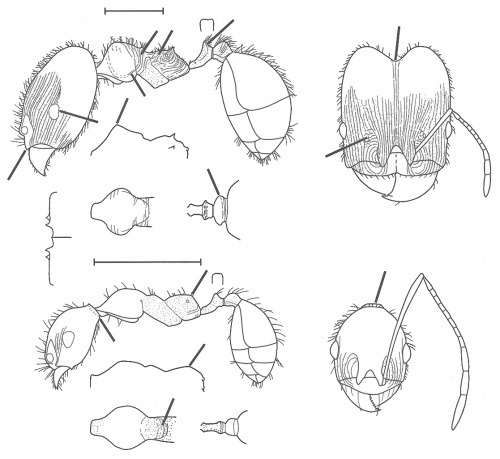Pheidole praeusta
| Pheidole praeusta | |
|---|---|

| |
| Scientific classification | |
| Kingdom: | Animalia |
| Phylum: | Arthropoda |
| Class: | Insecta |
| Order: | Hymenoptera |
| Family: | Formicidae |
| Subfamily: | Myrmicinae |
| Tribe: | Attini |
| Genus: | Pheidole |
| Species: | P. praeusta |
| Binomial name | |
| Pheidole praeusta Roger, 1863 | |
| Synonyms | |
| |
The nests of praeusta found by Forel at Barranquilla and Dibulla had a unique structure. The nest entrance of each was a convoluted slit surrounded by a narrow elevated earthen wall, 2 cm high off the level of the surrounding soil, 4 to 6 cm in diameter, and turning outward toward the upper rim, and overall “resembling the calyx of a large monopetalous flower.” Forel did not comment on the matter, but the praeusta entrance and superstructure are remarkably similar to the fortified cerumen nest entrances of some meliponine bees. (Wilson 2003)
Identification
See the description in the nomenclature section.
Keys including this Species
Distribution
Latitudinal Distribution Pattern
Latitudinal Range: 10.838° to -22.9°.
| North Temperate |
North Subtropical |
Tropical | South Subtropical |
South Temperate |
- Source: AntMaps; Guerrero et al., 2022
Distribution based on Regional Taxon Lists
Neotropical Region: Colombia (type locality).
Distribution based on AntMaps
Distribution based on AntWeb specimens
Check data from AntWeb
Countries Occupied
| Number of countries occupied by this species based on AntWiki Regional Taxon Lists. In general, fewer countries occupied indicates a narrower range, while more countries indicates a more widespread species. |

|
Estimated Abundance
| Relative abundance based on number of AntMaps records per species (this species within the purple bar). Fewer records (to the left) indicates a less abundant/encountered species while more records (to the right) indicates more abundant/encountered species. |

|
Biology
Castes
Worker
Minor
Images from AntWeb
   
| |
| Worker. Specimen code casent0281753. Photographer Shannon Hartman, uploaded by California Academy of Sciences. | Owned by NHMUK, London, UK. |
   
| |
| Paralectotype of Pheidole amata. Worker. Specimen code casent0908159. Photographer Will Ericson, uploaded by California Academy of Sciences. | Owned by MHNG, Geneva, Switzerland. |
Major
Images from AntWeb
   
| |
| Lectotype of Pheidole amata. Worker (major/soldier). Specimen code casent0908158. Photographer Will Ericson, uploaded by California Academy of Sciences. | Owned by MHNG, Geneva, Switzerland. |
Nomenclature
The following information is derived from Barry Bolton's Online Catalogue of the Ants of the World.
- praeusta. Pheidole praeusta Roger, 1863a: 197 (s.) COLOMBIA.
- Forel, 1901e: 361 (w.).
- See also: Wilson, 2003: 340.
- amata. Pheidole amata Forel, 1901e: 360 (s.w.) COLOMBIA.
- Junior synonym of praeusta: Guerrero et al., 2022: 325.
- See also: Wilson, 2003: 651.
Type Material
- Pheidole praeusta: Holotype soldier, "Island", Colombia, 1820 [[[MHNG|Musee d'Histoire Naturelle Genève]] CASENT0915435] (Wilson, 2003; Guerrero et al., 2022).
- Pheidole amata: Lectotype soldier, Orihueca, Río Frio, Magdalena, Colombia [[[MHNG|Musee d'Histoire Naturelle Genève]], CASENT0908158] (Wilson, 2003; Guerrero et al., 2022).
Description
From Wilson (2003): A member of a complex of Pheidole species, with giant majors and short bristly hair, in the larger fallax group comprising Pheidole astur, Pheidole oxyops, Pheidole praeusta and Pheidole trageri; praeusta is distinguished among them by the following combination of traits.
Major: rugoreticulum lacking on head; carinulae immediately next to the midline of the dorsal surface of the head reach the occiput; occipital lobes smooth and shiny; mesonotal convexity prominent; propodeal spines small, thin, and vertical to the basal propodeal face; postpetiolar node seen from above elliptical, with angulate lateral margins; anterior and lateral margins of pronotal dorsum transversely carinulate; propodeum completely carinulate.
Minor: occiput narrowed somewhat, with nuchal collar; dorsal margin of petiolar node bidentate in rear view; propodeal spine reduced to denticle; pronotum entirely smooth and shiny.
MEASUREMENTS (mm) Holotype major (Mus. National Hist. Nat. Paris): HW 2.34, HL 2.78, SL 1.10, EL 0.30, PW 0.92. Minor (Barranquilla, Colombia): HW 0.60, HL 0.78, SL 0.96, EL 0.16, PW 0.42.
COLOR Major: concolorous reddish yellow (“orange”).
Minor: body reddish brown except for gaster, which is dark brown.
Figure. Upper: major. Lower: minor. COLOMBIA: Barranquilla, col. Auguste Forel. Major compared with holotype major in Musee National d'Histoire Naturelle, Paris; the specimen is labeled “Island, Colombia, 1820” and lacks the waist and gaster. Scale bars = 1 mm.
Pheidole amata
From Wilson (2003): DIAGNOSIS Similar in various traits to Pheidole ambigua, Pheidole celaena, Pheidole fera, Pheidole germaini, Pheidole peruviana, Pheidole rutilana, Pheidole schwarzmaieri, Pheidole superba and Pheidole vomer, differing as follows.
Major: mostly reddish yellow; lower pronotal margin, upper half of mesopleuron, and sides of propodeum bearing curved carinulae, those on mesopleuron S-shaped; eye bean-shaped, with concave ventral border; clypeus prominent and long in side view but lacking any process; head subrectangular; occipital cleft deep; humerus in dorsal-oblique view prominent, subangulate; petiolar node thin in side view, and broad, elliptical, and marginally angular seen from above.
Minor: propodeal spine absent; occiput narrowed to a neck with nuchal collar; posterior half of mesonotum carinulate.
MEASUREMENTS (mm) Lectotype major: HW 1.54, HL 1.88, SL 0.82, EL 0.28, PW 0.80. Paralectotype minor: HW 0.56, HL 0.74, SL 0.86, EL 0.10, PW 0040.
COLOR Major: body reddish yellow except for gaster; which is plain medium brown; appendages reddish yellow. Minor: body medium brown, verging to yellow at level of clypeus; appendages medium yellow.
Figure. Upper: lectotype, major. Lower: paralectotype, minor. Scale bars = 1 mm.
References
- Wilson, E. O. 2003. Pheidole in the New World: A dominant, hyperdiverse ant genus. Harvard University Press, Cambridge, MA. (page 340, fig. major, minor described)
- Forel, A. 1901j. Variétés myrmécologiques. Ann. Soc. Entomol. Belg. 45: 334-382 (page 361, worker described)
- Guerrero, R.J., García, E., Fernández, F. 2022. The Pheidole Westwood, 1839 ants (Formicidae: Myrmicinae) in Colombia: new records including two species with remarkable morphology. Zootaxa 5154 (3): 319-332 (doi:10.11646/zootaxa.5154.3.5).
- Roger, J. 1863a. Die neu aufgeführten Gattungen und Arten meines Formiciden-Verzeichnisses nebst Ergänzung einiger früher gegebenen Beschreibungen. Berl. Entomol. Z. 7: 131-214 (page 197, soldier described)
References based on Global Ant Biodiversity Informatics
- Kempf, W.W. 1972. Catalago abreviado das formigas da regiao Neotropical (Hym. Formicidae) Studia Entomologica 15(1-4).




